I would not get that excited. It happens to make great goat fodder. With goats, an infestation can be hammered down as can other invasives.
We are certainly going there anyway. Goats are now been used and the herds will expand as landowners want the land cleared to use. Certainly urban areas are paying well for the service and we are seeing road work as well.
Insects may allow a permanent solution. but i would not count on that..
We are only beginning to understand knotweed’s ecological impacts. Animation by Lisa Larson-Walker. Photos by Chris Clor/Getty Images, Image Source/Getty Images.
Oh, No, Not Knotweed!
It grows rapidly. It’s nearly impossible to kill. It’s terrorized England. And now it’s all over my American backyard.
By Henry Grabar
May 08, 20195:45 AM
https://slate.com/technology/2019/05/japanese-knotweed-invasive-plants.html?
It’s been nearly four years since I bought hypodermic needles at a CVS, squatted in my backyard, and drew them full of glyphosate. I’d done my best to build a little garden in Brooklyn, only to see the ground begin to vanish beneath the fastest-growing plant I had ever seen. It sprouted in April with a pair of tiny, beet-red leaves between the flagstones, and poked up like asparagus through the mulch. By May the leaves were flat and green and bigger than my hands, and the stems as round as a silver dollar. My neighbor’s yard provided a preview of what was coming my way: a grove as thick as a cornfield, 10 feet high, from the windows to the lot line. I had to kill the knotweed.
I tried a few different approaches: Yanking it out stalk by stalk was a sweaty, summer-long game of whack-a-mole—a thankless full-time job. Then a friend and I spent one long night digging a 10-by-4-foot trench, lining it with black contractor bags, and refilling it with dirt. It looked like we were trying to bury something, and in a way we were: the knotweed rhizomes—the plant’s creeping rootstalks—under our feet, searching for a ray of light.
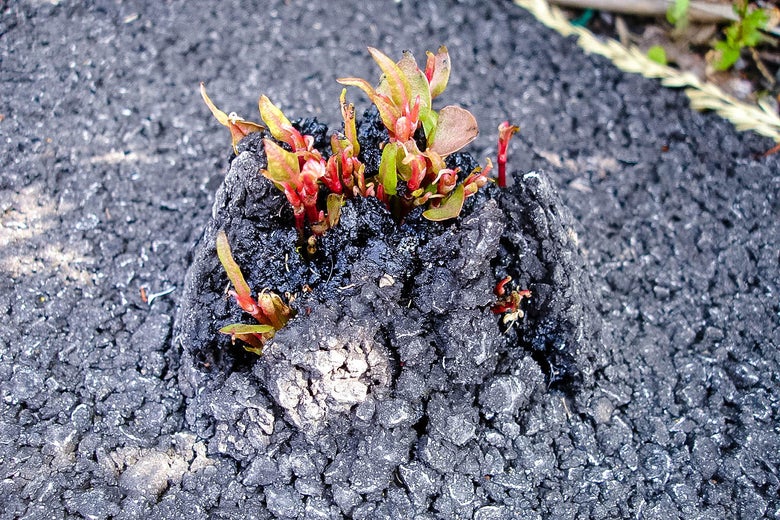
3
“If it’s growing close to your house, there’s a potential it could send its rhizomes and break through your foundation,” says Jatinder Aulakh, an assistant weed scientist at the Connecticut Agricultural Experiment Station.
Japanese Knotweed Solutions, Ltd.3
I was facing twin threats. The knotweed would kill my plants within months and prevent anything else from growing. But spraying the yard with Round-Up, Monsanto’s powerful herbicide, would kill everything in days. Which is why I bought the needles. The idea, which was tested in the journal Conservation Evidence, was to inject the plant’s hollow, jointed canes with weedkiller, shooting herbicide into its roots but sparing innocent neighbors from the deadly spray.3
In the moment, this felt absurd, a demented instruction from the Wile E. Coyote guide to gardening. This was before I knew that two full-time knotweed fighters had, in 2004, shot glyphosate into more than 28,000 knotweed stems along Oregon’s Sandy River. Or that in the United Kingdom, it has been a crime to plant or transport unsealed knotweed since 1990. Or that right here in New York City, more than 200 acres of parkland have been overtaken by the plant.3
Anyway, it didn’t work.
Japanese knotweed has come a long way since Philipp Franz von Siebold, the doctor-in-residence for the Dutch at Nagasaki, brought it to the Utrecht plant fair in the Netherlands in the 1840s. The gold-medal shrub was prized for its “gracious flowers” and advertised as ornament, medicine, wind shelter, soil retainer, dune stabilizer, cattle feed, and insect pollinator. The stems could be dried to make matchsticks, or cut and cooked like rhubarb. It crested in the dog days of summer with tassels of tiny white buds. Oh, and it grew with “great vigor.”
Infestation is “rapid and devastating,” one researcher wrote. “The plants are characterized by a strong will to live,” wrote another.
In 1850, von Siebold shipped a bundle of knotweed plants to Kew Gardens. From there, carried by gardeners, contractors, and floods, knotweed conquered the British Isles and dug its roots deep into the English psyche. In 2008, the novelist Jeffrey Archer released a best-selling revenge novel in which the protagonist crafts a strategy to sabotage an enemy via knotweed propagation. Archer believed knotweed had undermined the foundation of his own family home. The plant has worked its way into British vernacular—last year, a group of parliamentarians called Theresa May the “Japanese knotweed prime minister”; in April, soccer legend Gary Neville berated losing Manchester United players as knotweed in the locker room, “attacking the foundations of the house”—and has sprouted an industry of knotweed removal specialists, lawyers who chase their vans, and a tabloid press that can’t get enough of the invasive shrub and the human conflict it creates.
England and Wales are the most dramatic examples of knotweed’s spread in the West, but knotweed endures across the channel, too—as the most expensive invasive plant crisis on the continent, according to a 2009 study. And in recent decades, Japanese knotweed has colonized the Northeastern United States, the spine of the Appalachians, the Great Lakes states, and the Pacific Northwest. Infestation is “rapid and devastating,” one researcher wrote. “The plants are characterized by a strong will to live,” wrote another. In New Hampshire, a knotweed researcher told me he had found knotweed systems—almost certainly just one plant, connected underground—as large as 32,000 square feet, more than half the size of a football field.
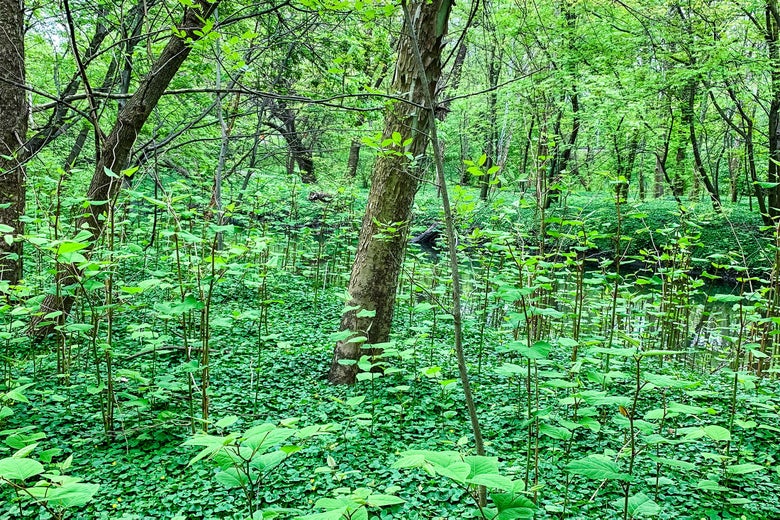
Knotweed rises on the banks of the Bronx River in New York City, where more than 200 acres of parkland is covered by knotweed.
Henry Grabar
Along streams and rivers, knotweed grows into a wall that hides the water. Along roads, its arching canes can make it hard to see around bends. In Bronx River Forest, knotweed once grew so thick that driving along its paths was “like being in a knotweed carwash,” New York City conservation manager Michael Mendez told me. “There were people living in the knotweed,” he recalled. It was a good place to hide.
Knotweed can grow through cracks in cement, between floorboards, and out from the joints in a stone wall. “You can see it everywhere, along the roadside, in every city,” said Jatinder Aulakh, an assistant weed scientist at the Connecticut Agricultural Experiment Station. In the landscapes it has infested, it is impossible to imagine what was there before—and harder still to foresee a future without it. “There is no insect, pest, or disease in the United States,” Aulakh said, “that can keep it in check.”
In the summer of 2013, a lab technician in the suburbs of Birmingham, England, beat his wife to death with a perfume bottle before killing himself several days later. In the interim, Kenneth McRae outlined the way he understood his own unraveling in a suicide note. “I believe I was not an evil man until the balance of my mind was disturbed by the fact that there is a patch of Japanese knotweed which has been growing over our boundary fence on the Rowley Regis Golf Course,” he wrote. “It has proved impossible to stop, and has made our unmortgaged property unsaleable. … The worry of it migrating onto our garden and subsequently undermining the structure over the next few years, with consequent legal battles which we won’t win, has led to my growing madness.”
No plant can excuse such violence. But the fear McRae describes, says Mark Montaldo, is not exactly irrational. Montaldo is a lawyer in Liverpool and the head of civil litigation at the firm Cobleys Solicitors. His three most profitable lines of work are personal injury suits, bad landlords, and Japanese knotweed.
When I first spoke to Montaldo, he was riding his bicycle outside the city. It was a pleasant day in early April, and across Great Britain, chalk-white knotweed stems were awakening underground. Montaldo expects the summer will bring his firm hundreds of inquiries from buyers fighting sellers, homeowners fighting contractors, and neighbors fighting neighbors—all over Fallopia japonica. “People are thinking, ‘It could totally make my house worthless,’ ” Montaldo told me. “And it can.”
At the heart of the Great British Knotweed Panic is the fear that knotweed will make your house fall down. The U.K. has made knotweed disclosure mandatory on all deeds of sale. British banks will not issue a mortgage to a property with knotweed on its grounds, or to one with knotweed growing nearby, unless a management plan is in place. In February, HSBC clarified its mortgage policy in a letter to a parliamentary committee, which was committed to addressing knotweed even in the midst of the Brexit chaos. Any knotweed growing within seven meters of a property is “unacceptable security,” said the country’s largest bank. A management plan can be a long and costly ordeal, with a bedroom-size clump of knotweed requiring thousands of dollars of treatment over several years. Homeowners with negligent neighbors or few resources have little recourse at all. In 2016, not far from the Rowley Regis course, a retired butcher named William Jones hanged himself in his home. At an inquest, his wife said he had been troubled by, among other things, the financial implications of knotweed on a piece of land he’d bought. “Bill was a very strong character,” she later told the Telegraph. “But this was something he couldn’t cope with.”
There is some dispute among biologists and engineers over whether the plant poses quite the threat banks and courts say it does. But there is no doubt that knotweed in the U.K. is perceived as an affliction, a shameful outbreak. “It’s a little bit like an STD,” said Mike Clough, a knotweed treatment specialist whose clients sometimes request that he arrive in an unmarked van. “You don’t want to talk about it, you don’t want people to know you’ve had it, you just want to get rid of it.” (Clough told me he routinely sees the plant intrude on inside spaces. “We did one hotel, where on opening day the hotel had lumps in the carpet,” he said. “They rolled it back, and knotweed was coming through.”)
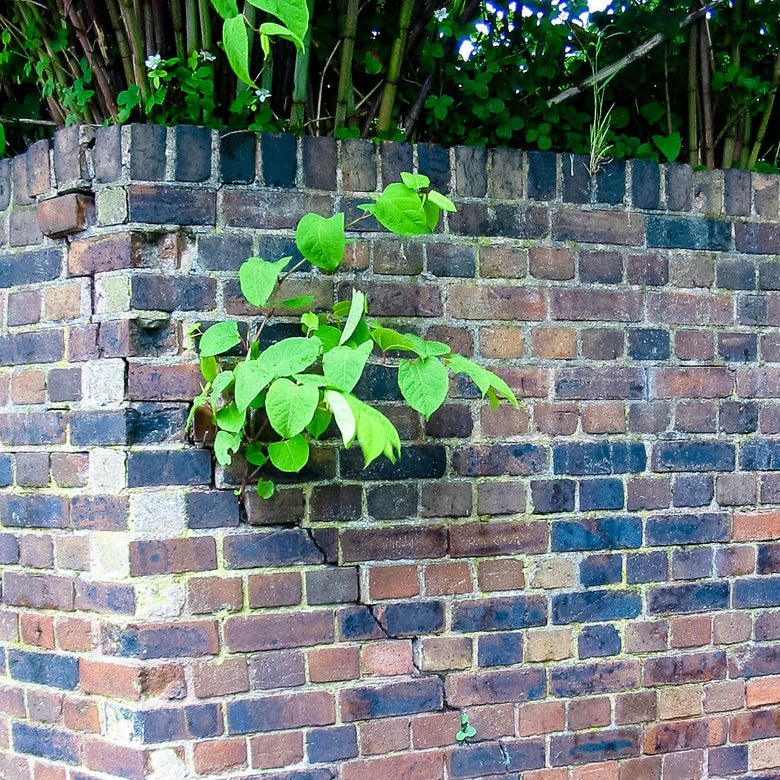
“The key problem, in contrast to most other invasive plants, is how difficult it is to kill,” says Dan Jones, who runs Advanced Invasives in Cardiff, Wales.
Japanese Knotweed Solutions, Ltd.
How did knotweed become so widespread in the U.K.? Only a female specimen had made the trip from Nagasaki to Utrecht to London to the watersheds of Ireland and Wales, so there were no knotweed seeds in the British Isles, just fragments of the plant’s underground stems. But that was enough. In 2000, biologists Michelle Hollingsworth and John Bailey analyzed 150 samples from across the U.K. and concluded that British knotweed was all a clone of that original plant, now one of the world’s largest. The DNA was identical. Not just one species but a single plant had conquered the entire United Kingdom..
That was possible because of knotweed’s astounding powers of asexual reproduction: A new plant can grow from a fingernail-size piece of root, and a century of building homes, roads, ditches, and levees—and dumping the dirt wherever it was convenient—helped put those fragments everywhere. So did flooding, which carried bits of root downstream. Barriers like walls and roads were no obstacle because knotweed roots can stretch as far as 70 feet from the nearest stem.
Did I mention that it’s really hard to kill?
Dan Jones—Twitter handle Knotweed_Doktor—has a Ph.D. in biology and runs a consultancy firm in Cardiff, Wales, called Advanced Invasives. When we spoke in March, he was preparing to fly to Southern California, whose famous dry climate means it is not a great place for knotweed—which means it is a great place for Jones to take his family on vacation. “I quite like that, and so does my wife, because I’m not spotting it.”
Advanced Invasives is in the business of tamping down knotweed using techniques like digging, cutting, and spraying a cocktail of herbicides. But Jones is forthright about the challenges involved and about the fact that living with knotweed might be your only option. His thesis, published last year in the journal Biological Invasions (less exciting than it sounds), was the most extensive field-based study of treating large knotweed patches. Its conclusion: “No treatment completely eradicated F. Japonica.”
“We did one hotel, where on opening day the hotel had lumps in the carpet. They rolled it back and knotweed was coming through.” — Mike Clough, knotweed treatment specialist
Consider a new housing development in Wales, where Jones was brought in to assess an infestation that measured about 50 by 60 feet. If Jones had his men dig down enough into the earth to be sure of catching the deepest chunks of root, he was looking at excavating nearly 5,000 cubic yards of soil—almost an entire American football field, dug out three feet deep—which would then have to be placed in a specially designated landfill, since knotweed had been classified by the government as “controlled waste,” the same category as some byproducts of nuclear power plants. The cost for off-site disposal would run into the hundreds of thousands of dollars. Removing knotweed from the site of the London Olympics was estimated to have cost about 70 million pounds.
Knotweed removal is even more complicated near streams and rivers, where the plant has found its deepest foothold, and overlapping property claims make large-scale cooperation difficult. Digging is often infeasible because running water is ever-present and likely to sprinkle rhizome fragments down the watercourse. Spraying is fraught because herbicide use is regulated around freshwater streams. Jones showed me side-by-side photos of a farmstead at the headwaters of the River Rhymney in South Wales, one taken in 1984 and the second in 2012. The first shows the confluence of two streams at the crook of the property. The second shows a forest of knotweed.
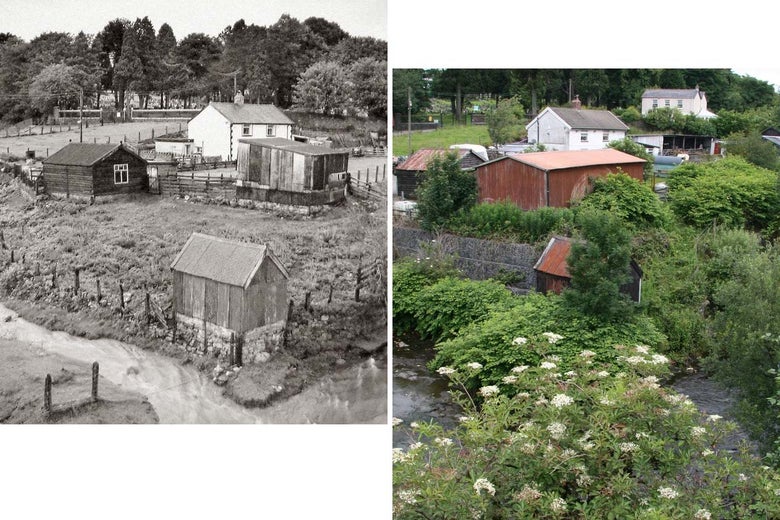
The headwaters of the River Rhymney in South Wales in 1984 and 2012.
Composite image by Slate. Photos by Gethin Bowes, Dan Jones.
In the late 1860s, James Hogg was running a nursery on East 84th Street in Manhattan when he received a gift from his brother Thomas, who was working in Japan. James was an acquaintance of the couple that started the New York Botanical Garden, and sometime around the turn of the 20th century, his friends decided to try a new planting in the Bronx.
You know what happened next. Knotweed has flourished in the U.S.—especially in the past few decades, driven by construction and flooding. Experts also believe that climate change plays a role, with disruptions like heavier rainfall, warmer winters, and the desynchronization of native plants and animals all favoring hardy invaders like knotweed. Knotweed is “out of control,” says the New York City Parks Department, which has spent almost $1 million treating just 30 acres of knotweed citywide since 2010.
The first American knotweed lawsuit, as far as I can tell, was decided in 2014, when Cynthia and Alan Inman of Scarsdale, New York, sued the owners of the shopping center next door, alleging the defendants had allowed knotweed to thrive on their property and, from there, undermine the Inmans’ property value. They won $535,000 in damages.
But because knotweed still has a relatively low profile in the United States, landowners can be confused and surprised when they first confront the plant. Carly Reynolds bought an old farmhouse on 13 acres in Rome, New York, in 2016, hoping to turn it into a restaurant and event space. The next spring, she found knotweed growing through the floorboards—offshoots from a thicket along the property boundary. “I was turning into a crazed person, watching it take over the property,” she recalled. Now she and her friends dedicate several days a year to knotweed control just to keep the plant at bay.
Knotweed is one in a long list of invasive plants to have prompted concern in the U.S. Pigweed, which plagues soybean farmers in the Midwest, has developed herbicide-resistant strains that alarm farmers and fascinate scientists. Californians are reckoning with their iconic eucalyptus trees, which are delightfully fragrant, non-native, and highly flammable. The panic over kudzu in the American South, while appealing to writers searching for symbolism in the landscape, turned out to have been quite a bit overblown.
“Frankly, kudzu pales by comparison in its effects to Japanese knotweed,” Robert Naczi, a curator of North American botany at the New York Botanical Garden, told me. “There are plenty of invasives [where] yes, they spread, but they’ve occupied most of the habitat that they will occupy. Japanese knotweed still has a ways to go and it appears it will—unless we do something we’ve not yet discovered—be successful in dominating the state of New York.”
The biggest problem with knotweed, Naczi explained, is that it grows so thickly there is no room for anything else. “I don’t want to ascribe moral agency to the plant,” he says. “It’s not an evil plant. It’s doing what a plant does. But Japanese knotweed is a very serious invasive. A very, very problematic species. One of the worst invasive species in Northeastern North America.”
We are only beginning to understand knotweed’s ecological impacts. Chad Hammer, a graduate student and researcher at the University of New Hampshire who has been traveling New England in search of knotweed, is one of the first people to study the plant’s environmental effects. Last year, he found that 30,000-square-foot infestation in Coos County, New Hampshire. In Vermont, he saw how the devastating floods unleashed by Hurricane Irene had, among other things, sprinkled the state’s watersheds with knotweed rhizomes. But it doesn’t take a hurricane: “When you’re working in a stream after a high-flow event, you’re very frequently seeing Japanese knotweed stems floating past you,” he told me. “They land somewhere else, and they start a new colony over there.”
Hammer has found three changes in infested landscapes. First, knotweed grows so densely that virtually no sunlight hits the ground in a knotweed forest. In the massive Coos County patch, he said, there were no more than two other plant species growing in the knotweed’s shadow. That, in turn, reduces the number of bugs that might live in that landscape. Where there are fewer bugs there are fewer birds, and so on.
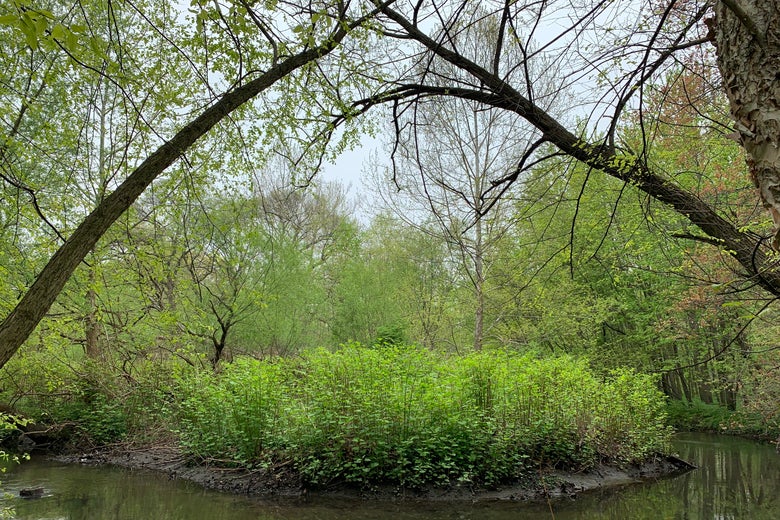
A knotweed infestation in the Bronx, where the riverbanks slough into the stream.
Henry Grabar
Second, and relatedly, new trees can’t grow in a knotweed monoculture, which is very bad for streams. In a native New England forest, dead branches play an indispensable role in shaping streams. Woody debris feeds bugs who feed trout. Logs create eddies and pools, which enhance stream habitats and provide places for sediment to collect, improving water quality downstream. Fewer trees, fewer pools, fewer bugs, fewer trout.
In knotweed colonies, Hammer also found that the ground was barren of organic material, which increased the likelihood of soil erosion during rainstorms. Sure enough, when Hammer looked at the boulders and cobbles in streambeds near knotweed growth, he found that rocks downstream from the plant were more likely to be coated in silt. That’s bad for fish and invertebrates who use the clean rocks for nesting, he said, and bad for humans whose water, down the line, may be carrying chemicals from fertilized soil that makes its way into the stream.
Hammer’s findings are a reminder that knotweed’s impact goes far beyond rickety floorboards and cracked asphalt. And yet, one thing nobody has learned about the plant is how to economically and effectively eliminate it. “It gives me tremendous frustration to give you the truth,” Naczi told me. “Our understanding is far behind the plant’s ability to expand and invade.”
Not everyone is as apocalyptic as Naczi. Several ecologists I spoke to argue that lawyers and contractors in the U.K. have sown paranoia over a pesky shrub. “The contractors’ marketing is highly spurious, but you have to give them credit,” says Max Wade, an engineer with the firm AECOM who has argued that knotweed is no more likely to undermine a house than a tree. (Still, you can kill a tree in a day, and you won’t have to tell the guy who buys your house that you did.) “They’ve done a great job convincing us it’s a demon plant.” Even Jones, the Knotweed_Doktor himself, decries what he calls “hysterical” media coverage, as well as a weed-control industry he thinks has taken advantage of a desperate and ill-informed clientele.
“It’s good for business if everyone’s terrified by it,” says the British biologist John Bailey, who is known to his peers as the God of Knotweed. “But nobody talks about the benefits.” Such as: Knotweed’s late-blooming flowers provide a snack for bees in the waning days of summer and produce a mild-flavored honey. Researchers in the Czech Republic have concluded that knotweed can be effectively processed into briquette biofuels because it grows so fast. Knotweed is rich in resveratrol, the family of molecules present in red wine and thought to be responsible for the health benefits associated with wine consumption. If it’s not growing in contaminated urban soil, it’s edible, with a lemony flavor and juicy crunch. Also, it’s just really interesting.
“It’s a giant natural experiment that allows us to think about how plants are evolving,” says Christina Richards, a biologist from the University of South Florida. Richards is fascinated by how knotweed exhibits diversity without genetic variation. It’s the antithesis of Darwin’s finches, which mated and mutated to suit their new habitats. Some knotweed hybridizes and evolves, but much of it does not change. It’s as at home on the volcanic slopes of Mt. Fuji as it is in New York parking lots and English gardens. It is a globalized super-specimen. “It loves so many types of environments—it’s a dream if you wanted to think about exposing a single individual to billions of different conditions.”
“So what makes it a dream for you is exactly what makes it a nightmare for everyone else?” I asked.
“Yes,” she answered.
All the methods devised by man to stop knotweed are too expensive, time-consuming, and inefficient.
We need a natural ally.
One thing that knotweed-loving biologists and knotweed-hating ecologists agree on is that humans have no chance of controlling the plant on a national scale. One of the most successful efforts at wild knotweed control was undertaken on Oregon’s Sandy River from 2001 to 2008, a project that super-scaled some of the techniques I had tried in the battle for my backyard—a battle that is, by the way, ongoing. Digging, cutting, injecting, spraying. Negotiating. Doing it all again, year after year.
It was an ambitious endeavor, run by the Nature Conservancy, with two full-time employees and a squad of volunteers. The team got cooperation from nearly 300 landowners to work on their properties, and some sites had to be accessed by boat. By 2008, stem count was down by 90 percent in the patches that had been treated. And yet: The team was unable to eradicate a single one of the biggest infestations, even after as many as nine treatments.
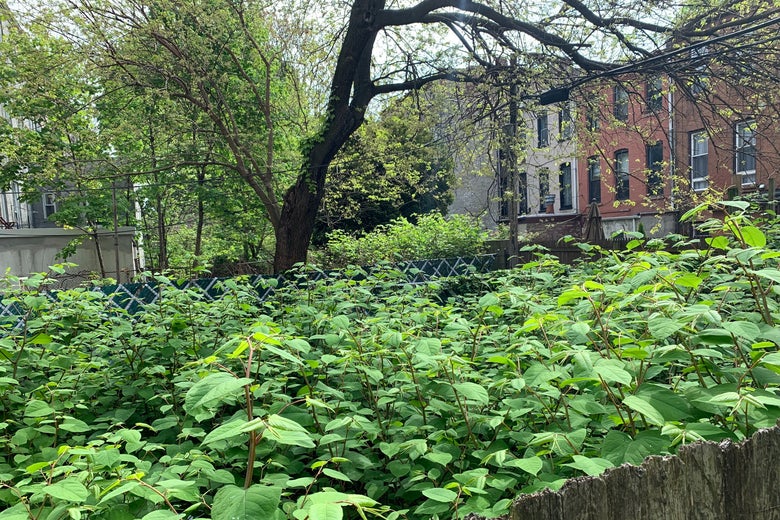
a view of the author’s neighbor’s yard.
Henry Grabar
All the methods devised by man to stop knotweed are too expensive, time-consuming, and inefficient.
We need a natural ally.
Enter Aphalaris itadori, a sap-sucking psyllid from Japan that eats knotweed for breakfast. (Itadori is the Japanese word for knotweed—this is the knotweed aphid.) In 2013, the U.S. Department of Agriculture’s Technical Advisory Group for Biological Control Agents of Weeds recommended the insect be evaluated for release in the United States.
This idea—fighting invasive species by introducing their native predators—is called biocontrol, and Roy Van Driesche, an entomologist at the University of Massachusetts–Amherst, believes it is the only approach for fighting knotweed at scale. He has been ready to drop psyllids on knotweed infestations around New England since 2011. Van Driesche has his sites. He has the money. He has watched the itadori bugs munch happily away at potted knotweed, and bred dozens of generations of these tiny critters in captivity, for more than five years. He has been waiting, fruitlessly, all that time, for the Animal and Plant Health Inspection Service of the USDA to grant him a permit. “They can wait you to death,” he said glumly.
The thing is, itadori might not even work, and Van Driesche knows it. Trials in the U.K. have brought mixed results, in part because native anthocorids gulped down the aphid eggs. At best, Van Driesche hopes for some decline in knotweed density a decade after introduction: The idea is not to eliminate the plant, but merely to “moderate its abundance” enough that native species can begin to compete.
On a cool day in early May, I caught a train north from Grand Central to the East Bronx. I saw knotweed all along the way: out the window at a construction site, on the embankments above the highway, and among the tulips in front yards on Burke Avenue. I was heading to meet Adam Thornbrough of the New York City Parks Department for a walk in the Bronx River Forest. Today, Thornbrough says, after nearly two decades of management, this is a place where the Parks Department has beaten back one of its biggest foes.
Once, knotweed so thrived here that in high summer the asphalt paths became tunnels, dark at noon beneath canes of knotweed bending toward the light. Volunteers spaced 10 feet apart used to march through the forest swinging machetes in each hand. Paths through the bush led to homeless encampments, to what one volunteer called the “knotweed people.”
But now, Thornbrough is feeling optimistic. On the river’s east bank, years of cutting, picking, and spraying have in places reduced the plant to a few wayward, scraggly stalks. (One great thing about a paucity of native plants? It’s easier to spray herbicide.) When I visited, the park was busy with volunteers organized by the Bronx River Alliance. They didn’t need machetes anymore. Groups of high schoolers filled the bed of a pickup truck with contractor bags of knotweed. The conservation crew leader told me she is here five days a week, and knotweed takes up 85 percent of her time, but she can finally see the river.
These clearings in the Bronx River Forest are a testament to the enormous human effort required to tame the plant. Here in one of the most densely populated neighborhoods of America’s biggest, richest city, we have broken knotweed’s hold.
But turn the corner on the river’s west bank, and neither the story nor the forest floor is so sunny. There, on the other side of the river, was more knotweed than I had ever seen in my life. “The Bronx River is one of the worst bodies in the state for knotweed. It’s on all the tributaries, it’s everywhere,” said Thornbrough, as we peered into a field of stalks just over a bridge from the culled fields.
Without the fibrous roots of native plants to anchor them, the riverbanks are sloughing into the stream. “It’s a biological wasteland,” Thornbrough said. We walked for a half-mile. Trees stood overhead; weeds grew underfoot. But in between, the only living thing was knotweed.
No comments:
Post a Comment